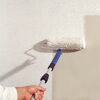It is fundamentally important for successful restoration that the causes of the mould infestation are remedied. On-site construction damage must be remedied and the users of the room must be informed about how mould infestation can be avoided in the future.
Basic information for ensuring restoration success
Small areas affected by fungi up to a size of 0.4 m² e.g. surface infestation (no damage to the building) can be remediated without the help of experts. Although we recommend seeking professional advice first. The general hygiene measures for working with biological work substances that are defined in the Technical Rules for workplace substances: ‘General hygiene measures: Minimum requirements" (TRBA 500) must be observed.
After working and before taking breaks, wash your hands and any other contaminated areas of skin with a cleaning agent and plenty of water. Due to the higher loads on the skin when wearing gloves, also apply a regenerating skin care agent to hands and fingers after the end of work. It is generally prohibited to eat, drink, smoke or chew tobacco or use cosmetics when working with biological workplace substances. After the restoration work, shower and wash your clothes. We advise a laboratory analysis to identify and quantify the mould before and after the restoration work.

Restoration of smaller surfaces < 0.5m²
Small areas affected by fungi up to a size of 0.4 m² e.g. surface infestation (no damage to the building) can be remediated without the help of experts. Although we recommend seeking professional advice first.
Restoration of larger surfaces > 0.5 m² (only by specialists)
Areas infested with mould greater than 0.4 m² must be treated by a qualified specialists. It is important that, in addition to the restoration, steps are taken to protect the residents from the exposed mould when it is being removed. Here, the health of the users must be considered.
Also, steps must be taken to prevent mould spreading to other areas. In case of larger areas of mould infestation, the infested areas need to be surrounded by dust-proof curtains (to minimise the spread of the mould). After the local mould has been remedied, the dust particles need to be removed from the environment of the restored areas (fine cleaning). After the end of the restoration work, clearance measurements must be taken.
Restoration & renewal without structural defects/interim solution
A basic prerequisite for successful restoration is the remedy of the causes of the mould infestation. On-site construction damage must be remedied and the users of the room must be informed about how mould infestation can be avoided in the future.
Color SA plus offers technically reliable protection wherever there are high levels of humidity in the room that cause microbial infestation.
Remmers Color SA plus is only an interim solution wherever condensation accumulates on the surface of building materials leading to microbial infestation. Here we advise the Remmers mould repair systems for the long-term: Mould restoration render system or mould restoration board systems.
Wherever microbial infestation results from moisture-saturated parts, the causes of the moisture need to be determined and corresponding restoration measures taken. Then we advise an interior coating with Remmers Color SA plus.
In the case of structural defects
Construction defects can lead to heat bridges or also parts that are not air tight. Both could be causes for problems with interior mould infestation. Mould restoration is only possible, if the constructive problems are remedied.
Long term measures
1 products foundView:
Article No. 298405
High quality, low-emission interior wall paint with micro-silver as a film preserver for protection against fungal attack

